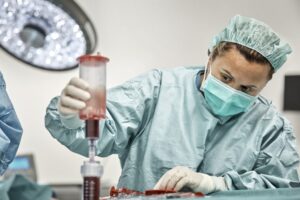Understanding how stem cells function within your body reveals the remarkable processes that support healing and renewal. Whenever you experience an injury, your body initiates a complex response to restore optimal health. The damaged tissue releases signals that travel through your bloodstream, prompting stem cells in your bone marrow to divide and migrate. This natural process is essential for tissue repair, as more stem cells become available in circulation to address the sites of injury.
Stemregen emerges as a powerful ally in enhancing this natural healing process. Featuring a blend of scientifically studied bioactives, this product supports the release and movement of stem cells from your bone marrow, increasing their presence in your bloodstream. As these stem cells arrive at the injury site, they multiply and transform into the specific cells needed for repair. With Stem cell technology, you can encourage your body’s innate ability to maintain health and vitality.
Understanding Stem Cells

Definition of Stem Cells
Stem cells are remarkable cells that possess the unique ability to develop into various types of cells in your body. They serve as a repair system, constantly replenishing your tissues and helping maintain your overall health. Unlike other cells, they have the potential to divide and differentiate into specialized cells, making them crucial for growth, healing, and tissue regeneration.
Types of Stem Cells
You can categorize stem cells into two primary types: embryonic and adult stem cells. Embryonic stem cells are derived from early-stage embryos and possess the ability to differentiate into every cell type in your body. On the other hand, adult stem cells, which exist in various tissues such as bone marrow and fat, are more specialized and typically give rise to a limited number of cell types relevant to their specific tissues.
Unique Properties of Stem Cells
What sets stem cells apart is their unique properties: self-renewal and differentiation. Self-renewal allows them to replicate themselves indefinitely, maintaining a reservoir of stem cells within your body. Differentiation refers to their ability to transform into specialized cells, like muscle or nerve cells, tailored to specific functions. These properties make stem cells invaluable in medical research and therapeutic applications.
The Role of Stem Cells in the Body
Repairing Injured Tissues
Whenever you experience an injury, stem cells jump into action. They play a critical role in repairing damaged tissues by migrating to injury sites, dividing, and differentiating into the cell types needed for healing. This natural response helps you recover more swiftly from wounds and injuries.
Regenerating Organs
Organs in your body can suffer from wear and tear, disease, or injury. Stem cells can assist in regenerating these organs by replacing damaged cells and contributing to tissue repair. Their regenerative capacity is what makes them a beacon of hope for those with degenerative diseases or organ failure.
Maintaining Homeostasis
Stem cells also play an essential role in maintaining homeostasis, the body’s balance. By constantly replacing old or damaged cells, they help keep your body functioning optimally. Through this process of cellular turnover, stem cells ensure that your body can respond effectively to changes and challenges.
How Stem Cells are Activated
Response to Injury
In the event of tissue damage, your body initiates a complex process to activate stem cells. Signals from the injured tissue prompt stem cells in the bone marrow to mobilize and migrate to the site of injury. This rapid response is crucial for effective healing.
Chemical Signals Involved in Activation
When injury occurs, affected tissues release specific compounds that serve as signals to stem cells. These chemical messengers, such as cytokines, inform the stem cells that there’s a problem and that a response is needed. Understanding these signals is vital for developing therapies that can enhance stem cell responses.

Role of Bone Marrow
Your bone marrow is a nurturing environment for stem cells. Once activated, stem cells exit the bone marrow and enter your bloodstream. This migration is a fundamental step that allows them to reach damaged tissues and begin their repair work.
The Journey of Stem Cells
Migration from Bone Marrow to Injury Sites
As soon as stem cells are mobilized, they travel through your bloodstream to reach the site of injury. This journey is crucial, as the farther they travel, the more potential there is for healing. Stem cells are driven by signals released from the damaged tissues, guiding them precisely to where their services are needed most.
The Role of Blood Circulation
Blood circulation plays an essential role in the migration of stem cells. It not only transports these cells to injury sites but also delivers oxygen and nutrients necessary for their functioning. The integrity of your vascular system is vital in ensuring that stem cells can effectively reach their target areas.
Interaction with Affected Tissues
Upon arriving at the injury site, stem cells interact with the damaged tissues to comprehend the specific requirements for healing. They begin to integrate into the tissue environment, which helps them initiate the repair process. This interaction is critical for successful regeneration and healing.
Stem Cells and Tissue Repair Mechanism

Division and Differentiation
Once stem cells reach the injury site, they swiftly begin to proliferate, or divide. This increase in cell numbers is essential for effectively repairing the damage. Following division, stem cells differentiate into specialized cell types relevant to the affected tissue, whether it’s muscle, skin, or nerve cells.
Transformation into Specialized Cells
Differentiation is more than just a process of division; it’s a transformation. Stem cells gradually morph into specialized cells, gaining unique structures and functions essential to their new roles. This specialization enables the rebuilding of damaged tissues, restoring their original function over time.
Amplification of Stem Cells
Through successive cycles of division and differentiation, one stem cell can give rise to thousands of specialized cells. This amplification is a powerful mechanism that enhances the healing process, ensuring that sufficient cells are available for tissue repair.
Factors Influencing Stem Cell Function
Stromal-Derived Factor 1 (SDF-1)
One of the critical factors influencing stem cell migration and activation is a protein known as Stromal-Derived Factor 1 (SDF-1). It is released by injured tissues and acts like a beacon, guiding stem cells to the site of damage. Understanding this factor opens up pathways for enhancing stem cell therapies.

Role of Compounds Released from Injured Tissues
Injured tissues release various biochemical compounds that play a crucial role in stem cell mobilization and activity. These compounds not only attract stem cells to the injury site but also promote their survival and differentiation, supporting the healing process.
Environmental and Nutritional Factors
The environment surrounding stem cells also impacts their function. Factors such as oxygen levels, pH, and nutrient availability can influence how effectively stem cells work. A well-balanced diet and a healthy lifestyle can foster an optimal environment, allowing stem cells to perform their repair functions efficiently.
Therapeutic Uses of Stem Cells
Stem Cell Therapy for Chronic Diseases
Stem cell therapy holds immense promise for treating chronic diseases such as diabetes, heart disease, and neurological disorders. By targeting the underlying causes of these conditions, stem cells can potentially regenerate damaged tissues and restore functionality, improving your quality of life.
Applications in Regenerative Medicine
Regenerative medicine relies heavily on stem cells to repair and rebuild damaged organs and tissues. Techniques such as stem cell transplantation and tissue engineering leverage the unique properties of stem cells to promote healing and regeneration in a targeted manner.
Potential in Sports Medicine
In sports medicine, stem cell therapies are gaining traction for treating injuries and joint disorders. Athletes are increasingly looking to stem cell treatments to expedite recovery and enhance performance by promoting faster healing of muscles and connective tissues.
Current Research on Stem Cells
Advancements in Stem Cell Science
As research continues, advancements in stem cell science are constantly evolving. Scientists are uncovering new methods to isolate, activate, and apply stem cells in clinical settings. These breakthroughs expand the potential applications of stem cells in various medical fields, paving the way for innovative treatments.
Studying Stem Cell Behavior
Researchers are actively studying how stem cells behave in different environments and conditions. By understanding the intricacies of stem cell biology, scientists can identify ways to enhance their therapeutic efficacy, ultimately leading to improved treatment outcomes for patients.
Ethical Considerations in Stem Cell Research
Despite the promise that stem cell research holds, ethical considerations remain a critical discussion point. Balancing the potential benefits of stem cell therapies with ethical considerations surrounding sources and applications is vital to advancing this field responsibly.
Stem Cell Enhancers
Natural Products and Bioactives
Several natural products and bioactive compounds have been identified as stem cell enhancers, promoting the mobilization and function of stem cells. These substances can act as supportive agents, helping to optimize the body’s natural healing processes.
Understanding Stemregen
Stemregen is one such product that features a proprietary blend of concentrated bioactives aimed at supporting the release and migration of stem cells. By enhancing the body’s capacity for repair and renewal, Stemregen illustrates the promising potential of natural approaches in integrating with modern medicine.
Impacts on Stem Cell Mobilization
Research has shown that products like Stemregen can increase the number of circulating stem cells in your bloodstream. This elevation in stem cell levels means more resources are available for tissue repair, leading to a more efficient healing process.
Conclusion
Summary of Stem Cell Functions
In summary, stem cells play essential roles in repairing injuries, regenerating tissues, and maintaining homeostasis in your body. Their unique properties, including self-renewal and differentiation, empower them to respond to your body’s needs swiftly.
Impact on Modern Medicine
The advancements in stem cell research have significantly impacted modern medicine, offering new avenues for treating chronic diseases and improving recovery processes. Stem cell therapies hold transformative potential for various medical challenges that previously lacked effective solutions.
Future Prospects in Research
With ongoing research focused on understanding and harnessing the power of stem cells, the future looks promising. As scientists continue to decode the complexities of stem cell biology, we can expect further advancements that will shape the future of medicine, improving health outcomes for everyone. Stem cells have the extraordinary ability to repair and regenerate damaged cells, making them a promising solution for many chronic conditions. However, traditional stem cell therapy is often out of reach due to high costs, the need for donors, or the requirement to travel abroad. Fortunately, a groundbreaking stem cell technology is now available, offering a more affordable and accessible way to experience these benefits.
This technology complements healthy lifestyle habits—like eating well, exercising, and reducing toxins—to enhance the body’s natural healing processes. It accelerates recovery, supports immune function, and combats inflammation by strengthening your cells. To learn how this innovative solution can benefit you, your loved ones, or those facing health challenges, contact us at stemboost with the subject “AIWNBOX.”


![[Understanding the Role of Genetics in Nutrition]](https://stemcelltreatmentprogram.com/wp-content/uploads/2024/12/understanding-the-role-of-genetics-in-nutrition.png)
![[The Science Behind Nutrition: What You Should Know]](https://stemcelltreatmentprogram.com/wp-content/uploads/2024/12/the-science-behind-nutrition-what-you-should-know.png)
